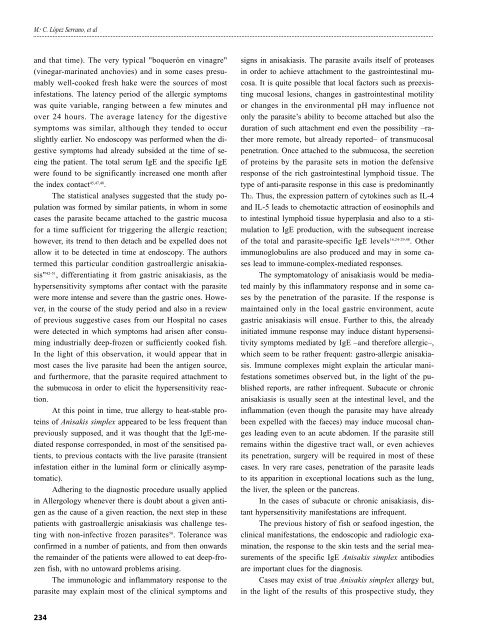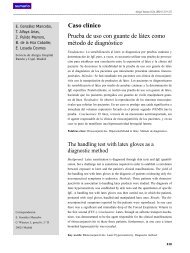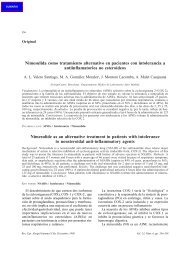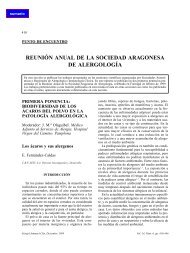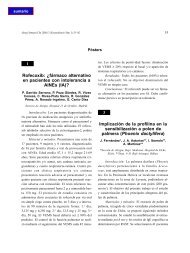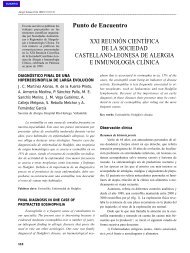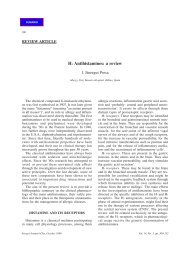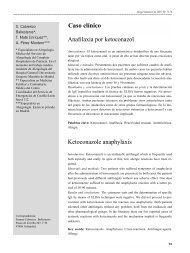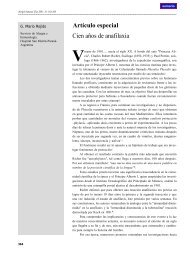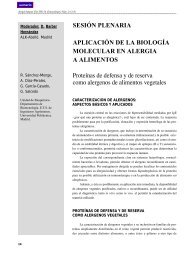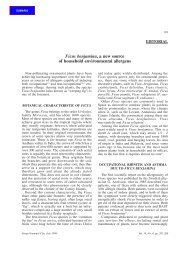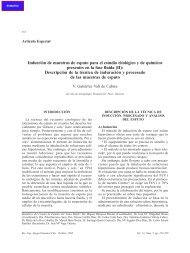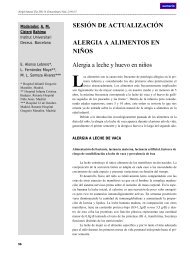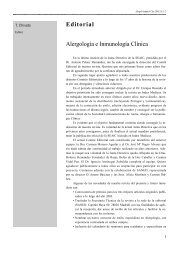Gastroallergic anisakiasis: immediate ... - Revista seaic
Gastroallergic anisakiasis: immediate ... - Revista seaic
Gastroallergic anisakiasis: immediate ... - Revista seaic
Create successful ePaper yourself
Turn your PDF publications into a flip-book with our unique Google optimized e-Paper software.
M. a C. López Serrano, et al<br />
and that time). The very typical "boquerón en vinagre"<br />
(vinegar-marinated anchovies) and in some cases presumably<br />
well-cooked fresh hake were the sources of most<br />
infestations. The latency period of the allergic symptoms<br />
was quite variable, ranging between a few minutes and<br />
over 24 hours. The average latency for the digestive<br />
symptoms was similar, although they tended to occur<br />
slightly earlier. No endoscopy was performed when the digestive<br />
symptoms had already subsided at the time of seeing<br />
the patient. The total serum IgE and the specific IgE<br />
were found to be significantly increased one month after<br />
the index contact 45,47,48 .<br />
The statistical analyses suggested that the study population<br />
was formed by similar patients, in whom in some<br />
cases the parasite became attached to the gastric mucosa<br />
for a time sufficient for triggering the allergic reaction;<br />
however, its trend to then detach and be expelled does not<br />
allow it to be detected in time at endoscopy. The authors<br />
termed this particular condition gastroallergic <strong>anisakiasis</strong>"<br />
42-51 , differentiating it from gastric <strong>anisakiasis</strong>, as the<br />
hypersensitivity symptoms after contact with the parasite<br />
were more intense and severe than the gastric ones. However,<br />
in the course of the study period and also in a review<br />
of previous suggestive cases from our Hospital no cases<br />
were detected in which symptoms had arisen after consuming<br />
industrially deep-frozen or sufficiently cooked fish.<br />
In the light of this observation, it would appear that in<br />
most cases the live parasite had been the antigen source,<br />
and furthermore, that the parasite required attachment to<br />
the submucosa in order to elicit the hypersensitivity reaction.<br />
At this point in time, true allergy to heat-stable proteins<br />
of Anisakis simplex appeared to be less frequent than<br />
previously supposed, and it was thought that the IgE-mediated<br />
response corresponded, in most of the sensitised patients,<br />
to previous contacts with the live parasite (transient<br />
infestation either in the luminal form or clinically asymptomatic).<br />
Adhering to the diagnostic procedure usually applied<br />
in Allergology whenever there is doubt about a given antigen<br />
as the cause of a given reaction, the next step in these<br />
patients with gastroallergic <strong>anisakiasis</strong> was challenge testing<br />
with non-infective frozen parasites 50 . Tolerance was<br />
confirmed in a number of patients, and from then onwards<br />
the remainder of the patients were allowed to eat deep-frozen<br />
fish, with no untoward problems arising.<br />
The immunologic and inflammatory response to the<br />
parasite may explain most of the clinical symptoms and<br />
signs in <strong>anisakiasis</strong>. The parasite avails itself of proteases<br />
in order to achieve attachment to the gastrointestinal mucosa.<br />
It is quite possible that local factors such as preexisting<br />
mucosal lesions, changes in gastrointestinal motility<br />
or changes in the environmental pH may influence not<br />
only the parasite’s ability to become attached but also the<br />
duration of such attachment end even the possibility –rather<br />
more remote, but already reported– of transmucosal<br />
penetration. Once attached to the submucosa, the secretion<br />
of proteins by the parasite sets in motion the defensive<br />
response of the rich gastrointestinal lymphoid tissue. The<br />
type of anti-parasite response in this case is predominantly<br />
Th2. Thus, the expression pattern of cytokines such as IL-4<br />
and IL-5 leads to chemotactic attraction of eosinophils and<br />
to intestinal lymphoid tissue hyperplasia and also to a stimulation<br />
to IgE production, with the subsequent increase<br />
of the total and parasite-specific IgE levels 16,24-29,48 . Other<br />
immunoglobulins are also produced and may in some cases<br />
lead to immune-complex-mediated responses.<br />
The symptomatology of <strong>anisakiasis</strong> would be mediated<br />
mainly by this inflammatory response and in some cases<br />
by the penetration of the parasite. If the response is<br />
maintained only in the local gastric environment, acute<br />
gastric <strong>anisakiasis</strong> will ensue. Further to this, the already<br />
initiated immune response may induce distant hypersensitivity<br />
symptoms mediated by IgE –and therefore allergic–,<br />
which seem to be rather frequent: gastro-allergic <strong>anisakiasis</strong>.<br />
Immune complexes might explain the articular manifestations<br />
sometimes observed but, in the light of the published<br />
reports, are rather infrequent. Subacute or chronic<br />
<strong>anisakiasis</strong> is usually seen at the intestinal level, and the<br />
inflammation (even though the parasite may have already<br />
been expelled with the faeces) may induce mucosal changes<br />
leading even to an acute abdomen. If the parasite still<br />
remains within the digestive tract wall, or even achieves<br />
its penetration, surgery will be required in most of these<br />
cases. In very rare cases, penetration of the parasite leads<br />
to its apparition in exceptional locations such as the lung,<br />
the liver, the spleen or the pancreas.<br />
In the cases of subacute or chronic <strong>anisakiasis</strong>, distant<br />
hypersensitivity manifestations are infrequent.<br />
The previous history of fish or seafood ingestion, the<br />
clinical manifestations, the endoscopic and radiologic examination,<br />
the response to the skin tests and the serial measurements<br />
of the specific IgE Anisakis simplex antibodies<br />
are important clues for the diagnosis.<br />
Cases may exist of true Anisakis simplex allergy but,<br />
in the light of the results of this prospective study, they<br />
234


